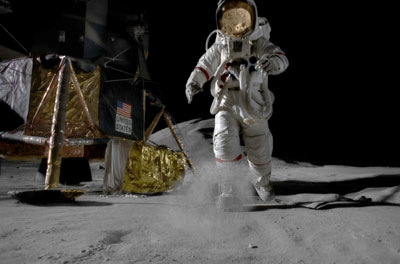Review: Magnificent Desolationby Jeff Foust
|
| “It was very realistic,” said Apollo 16 astronaut Charlie Duke. “It brought me right back onto the lunar surface.” |
However, the movie is more than just reenactments of the Apollo missions, something that might be even slightly disappointing to those who expected a special effects extravaganza for the entire length of the film. The movie attempts to tie these lunar vignettes with a broader, historical picture of why and how we went to the Moon. Children are quizzed about how much they know about Apollo and whether they themselves would like to go to the Moon. The film even takes a playful jab at those conspiracy theorists who allege that we never event went to the Moon. (Some reviews have criticized the movie for effectively providing ammunition to Moon landing debunkers by showing that it possible to realistically simulate humans on the Moon. They forget, though, that the Apollo landings took place three and a half decades ago, and this movie represents the state of the art in special effects in 2005: executive producer Hugh Murray, a veteran of IMAX movies, called this movie “the hardest I’ve ever done”, noting that “every frame was a special effect.” Try doing that in 1969.)
There are a couple of places where Magnificent Desolation does fall a little flat. One part of the movie is not a reenactment of one of the Apollo missions but instead an enactment of a what-if scenario: what happens if there was a rover accident and the two fictional astronauts riding it had to walk back to the lander? It’s an interesting dramatic exercise, but it suggests that the actual missions themselves were not dramatic enough; I for one would have preferred the nail-biting descent of Apollo 11 to the lunar surface over a fictional rover accident. (Moreover, how many people will leave the theater asking on what actual mission the astronauts crashed the rover?) The final scenes, where the film tries to tie the present desire of a little girl to go to the Moon with a vision of a grandiose future Moonbase, seem like too deliberate an attempt to tug at the heartstrings of the audience.
The timing of Magnificent Desolation is fortuitous: it has been released just as NASA is trying to sell Congress and the public on a bold new human return to the Moon. The reaction to that plan, as gauged by comments by members of Congress and editorials in the media, has been lukewarm at best: after all, some note, we already went to the Moon 35 years ago, so why do we need to spend $100 billion to do it again? No doubt some are pinning their hopes for winning over the public to the new plan in part on the stunning portrayal of past lunar exploration provided by Magnificent Desolation. Can it succeed? The audience for the film will be self-selecting towards those who already have an interest in space exploration; many will see the movie in IMAX theaters in science museums. However, Magnificent Desolation is a powerful film: regardless of the level of interest or passion you have for space exploration, it will be difficult not to feel moved after seeing this movie. It is a testament to the extraordinary feat of exploration that was Apollo—and that which may be yet to come.
